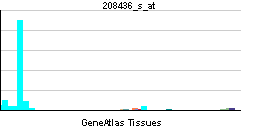IRF7
| Interferon regulatory factor 7 | |||||||||||
|---|---|---|---|---|---|---|---|---|---|---|---|
| Identifiers | |||||||||||
| Symbols | IRF7 ; IRF-7H; IRF7A | ||||||||||
| External IDs | Template:OMIM5 Template:MGI HomoloGene: 1209 | ||||||||||
| |||||||||||
| RNA expression pattern | |||||||||||
 | |||||||||||
| More reference expression data | |||||||||||
| Orthologs | |||||||||||
| Template:GNF Ortholog box | |||||||||||
| Species | Human | Mouse | |||||||||
| Entrez | n/a | n/a | |||||||||
| Ensembl | n/a | n/a | |||||||||
| UniProt | n/a | n/a | |||||||||
| RefSeq (mRNA) | n/a | n/a | |||||||||
| RefSeq (protein) | n/a | n/a | |||||||||
| Location (UCSC) | n/a | n/a | |||||||||
| PubMed search | n/a | n/a | |||||||||
Interferon regulatory factor 7, also known as IRF7, is a member of the Interferon Regulatory Factor transcription factor family.
IRF7 encodes interferon regulatory factor 7, a member of the interferon regulatory transcription factor (IRF) family. IRF7 has been shown to play a role in the transcriptional activation of virus-inducible cellular genes, including interferon beta chain genes. Inducible expression of IRF7 is largely restricted to lymphoid tissue. Multiple IRF7 transcript variants have been identified, although the functional consequences of these have not yet been established.[1]
See also
References
Further reading
- Pitha PM, Au WC, Lowther W; et al. (1999). "Role of the interferon regulatory factors (IRFs) in virus-mediated signaling and regulation of cell growth". Biochimie. 80 (8–9): 651–8. PMID 9865487.
- Zhang L, Pagano JS (2002). "Structure and function of IRF-7". J. Interferon Cytokine Res. 22 (1): 95–101. doi:10.1089/107999002753452700. PMID 11846980.
- Zhang L, Pagano JS (1997). "IRF-7, a new interferon regulatory factor associated with Epstein-Barr virus latency". Mol. Cell. Biol. 17 (10): 5748–57. PMID 9315633.
- Wathelet MG, Lin CH, Parekh BS; et al. (1998). "Virus infection induces the assembly of coordinately activated transcription factors on the IFN-beta enhancer in vivo". Mol. Cell. 1 (4): 507–18. PMID 9660935.
- Au WC, Moore PA, LaFleur DW; et al. (1998). "Characterization of the interferon regulatory factor-7 and its potential role in the transcription activation of interferon A genes". J. Biol. Chem. 273 (44): 29210–7. PMID 9786932.
- Lu R, Au WC, Yeow WS; et al. (2000). "Regulation of the promoter activity of interferon regulatory factor-7 gene. Activation by interferon snd silencing by hypermethylation". J. Biol. Chem. 275 (41): 31805–12. doi:10.1074/jbc.M005288200. PMID 10924517.
- Paris MJ, Williams BR (2001). "Characterization of a 500-kb contig spanning the region between c-Ha-Ras and MUC2 on chromosome 11p15.5". Genomics. 69 (2): 196–202. doi:10.1006/geno.2000.6339. PMID 11031102.
- Marié I, Smith E, Prakash A, Levy DE (2000). "Phosphorylation-induced dimerization of interferon regulatory factor 7 unmasks DNA binding and a bipartite transactivation domain". Mol. Cell. Biol. 20 (23): 8803–14. PMID 11073981.
- Smith EJ, Marié I, Prakash A; et al. (2001). "IRF3 and IRF7 phosphorylation in virus-infected cells does not require double-stranded RNA-dependent protein kinase R or Ikappa B kinase but is blocked by Vaccinia virus E3L protein". J. Biol. Chem. 276 (12): 8951–7. doi:10.1074/jbc.M008717200. PMID 11124948.
- Au WC, Yeow WS, Pitha PM (2001). "Analysis of functional domains of interferon regulatory factor 7 and its association with IRF-3". Virology. 280 (2): 273–82. doi:10.1006/viro.2000.0782. PMID 11162841.
- Lu R, Moore PA, Pitha PM (2002). "Stimulation of IRF-7 gene expression by tumor necrosis factor alpha: requirement for NFkappa B transcription factor and gene accessibility". J. Biol. Chem. 277 (19): 16592–8. doi:10.1074/jbc.M111440200. PMID 11877397.
- Morin P, Bragança J, Bandu MT; et al. (2002). "Preferential binding sites for interferon regulatory factors 3 and 7 involved in interferon-A gene transcription". J. Mol. Biol. 316 (5): 1009–22. doi:10.1006/jmbi.2001.5401. PMID 11884139.
- Caillaud A, Prakash A, Smith E; et al. (2003). "Acetylation of interferon regulatory factor-7 by p300/CREB-binding protein (CBP)-associated factor (PCAF) impairs its DNA binding". J. Biol. Chem. 277 (51): 49417–21. doi:10.1074/jbc.M207484200. PMID 12374802.
- Izmailova E, Bertley FM, Huang Q; et al. (2003). "HIV-1 Tat reprograms immature dendritic cells to express chemoattractants for activated T cells and macrophages". Nat. Med. 9 (2): 191–7. doi:10.1038/nm822. PMID 12539042.
- Yang H, Lin CH, Ma G; et al. (2003). "Interferon regulatory factor-7 synergizes with other transcription factors through multiple interactions with p300/CBP coactivators". J. Biol. Chem. 278 (18): 15495–504. doi:10.1074/jbc.M212940200. PMID 12604599.
- Ning S, Hahn AM, Huye LE, Pagano JS (2003). "Interferon regulatory factor 7 regulates expression of Epstein-Barr virus latent membrane protein 1: a regulatory circuit". J. Virol. 77 (17): 9359–68. PMID 12915551.
- Fitzgerald KA, Rowe DC, Barnes BJ; et al. (2003). "LPS-TLR4 signaling to IRF-3/7 and NF-kappaB involves the toll adapters TRAM and TRIF". J. Exp. Med. 198 (7): 1043–55. doi:10.1084/jem.20031023. PMID 14517278.
- Lin R, Noyce RS, Collins SE; et al. (2004). "The herpes simplex virus ICP0 RING finger domain inhibits IRF3- and IRF7-mediated activation of interferon-stimulated genes". J. Virol. 78 (4): 1675–84. PMID 14747533.
External links
- IRF7+protein,+human at the US National Library of Medicine Medical Subject Headings (MeSH)
| This article on a gene on human chromosome 11 is a stub. You can help Wikipedia by expanding it. |
This article incorporates text from the United States National Library of Medicine, which is in the public domain.